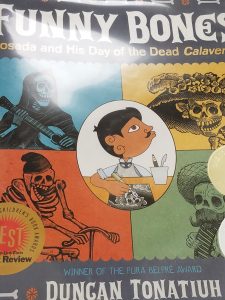
Title: Funny Bones
Author(s) Duncan Tonatiuh
Illustrator/Photographer Duncan Tonatiuh
Publisher and Year: Harry N. Abrams, 2015
Number of pages: 40
Tags/Themes: Award Book, Culture, Diversity, Fine Arts, Non-fiction, Picture Book, 4-5, Evan White
Genre: biography; art; history; cultural picture book, children
Descriptive Annotation: Funny Bones is biography of José Guadalupe (Lupe) Posada. Lupe was a famous Mexican artist in the late 1800s and early 1900s. He was most famous for his calaveras (skull or skeleton drawings). The book starts at Lupe’s childhood and how he learned different art forms like lithography and wood engraving. As Lupe grew older, he opened his own shop in Mexico City and would draw calaveras in current political events like the Mexican revolution and the corrupt government at the time. The students will need no background knowledge as the book explains the Spanish words and what Day of the Dead is. The author’s note has a detailed explanation of Day of the Dead with its history of calaveras. There is also a glossary of Spanish words for a more detailed definition .
Classroom Application: This text can be used to reinforce social science and used to give more detail into Day of the Dead and its culture. This book could be used in a series for students to compare and contrast Day of the Dead and Halloween so the students understand the cultural differences and appreciate the differences. This book does an excellent job showcasing the artwork for Day of the Dead, with the detail in the calaveras. Funny Bones could also be used to reinforce poetry. Calavera drawings could have a funny poem with the drawing, and the students can work on creating fun and silly poems.
Linguistic and Cultural Diversity Analysis: Funny Bones would teach about the art culture within the Mexican Culture, diving deep into different aspects of Mexican culture. I might introduce this book by introducing the art forms of drawing calaveras first or give the students a picture of calaveras, and they have to create a poem around the photo. Funny Bones also shows different aspects of Day of the Dead. “On those days, the city was full of vendors who sold pan de muerto (bread), cempasúchil (marigold flowers), alfeñiques (sugar Skulls), and papel picado (paper cutouts). People bought these and other items to decorate the ofrendas (offerings they made for their loved ones who had died)” (15). This quote gives an insight into what a day is like and what people would normally buy during this time. On page 17, there is a drawing of a calavera proposing so another calavera. “I am sorry Senñor. But that cannot be. You’re handsome and all, but too skinny for me!” This can be a good example for the students for what poems in calaveras are like. They are short and sweet with some humor in them. The text is printed on the poster of the calavera drawings with distinct font.
